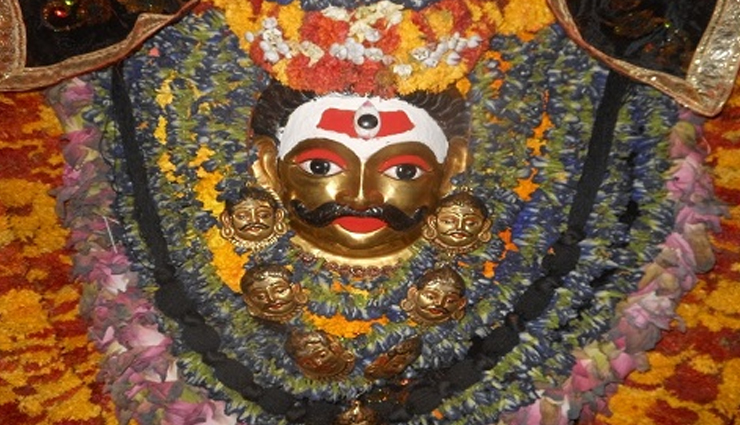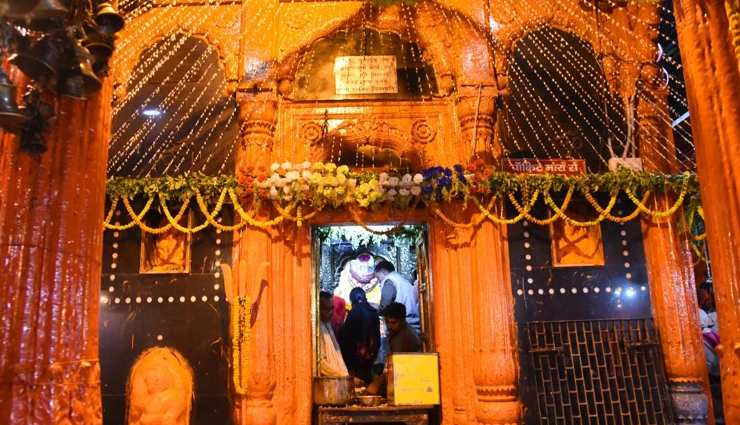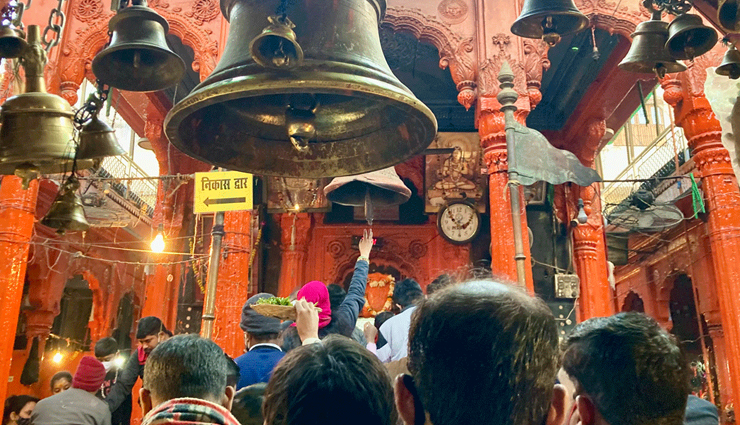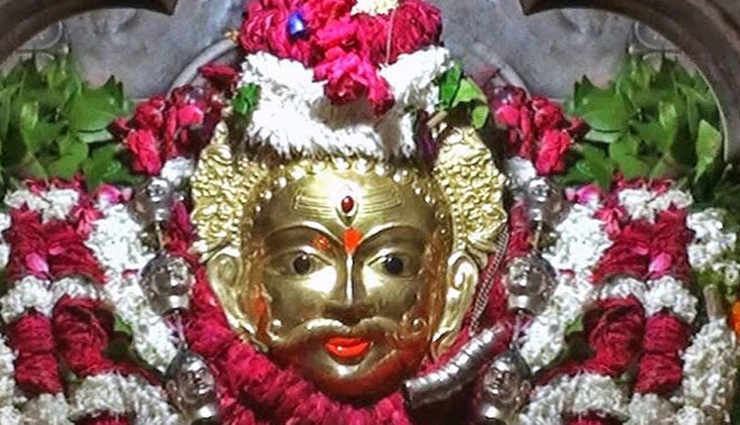Weird Facts About Kaal Bhairav Nath Temple, Varanasi, Uttar Pradesh
By: Priyanka Maheshwari Sat, 29 July 2023 6:08:42

The temple, commonly referred to as Batuk Bhairav Mandir, is a popular destination for pilgrims visiting Varanasi along with the renowned Kashi Vishwanath temple. Situated in the old city, it is just a short distance away from the main temple and the ghats along the sacred River Ganges. Accessible through a narrow alleyway, the temple welcomes visitors with the resonating sounds of chants and bells. The prevailing belief is that Lord Shiva, manifested as Batuk Bhairav, safeguards the city's residents, drawing both locals and tourists who seek his blessings.
The powerful verses on the lips of every resident of Kashi extol the fearsome yet compassionate nature of Kaal Bhairav. The mere sight of his image is believed to absolve sins, a testament to his deep connection with this revered city.
The term "Bhairav" is a fusion of three words: "Bha" represents creation, "Ra" stands for sustenance, and "Va" symbolizes destruction, embodying the combined essence of Brahma, Vishnu, and Mahesh, respectively.
The mythological tale of Kaal Bhairav's origin traces back to a significant event that gave rise to numerous legends, including the Jyotirlinga, the four-headed Brahma, and the establishment of Shaivism's supremacy.
According to the story, a dispute arose between Lord Vishnu and Brahma, questioning their individual supremacy among the triad: Brahma as the creator, Vishnu as the sustainer, and Shiva as the destroyer. A radiant pillar emerged from the ground and challenged them to find its end. While Vishnu humbly acknowledged the omnipresence of the divine, Brahma embarked on a quest to discover the pillar's apex. Despite his efforts, Brahma failed to find its end and resorted to a display of false authority. This act infuriated Shiva, leading to the emergence of the fierce form of Rudra from his matted locks, which he hurled on the mighty Mandrachal mountain.
In response to Brahma's audacity, Shiva commanded Bhairav to punish Brahma by severing his fifth head, which had uttered insults against Shiva.

Upon receiving the command, the fierce Kaal Bhairav swiftly severed Brahma's fifth head using just his little fingernail. Strangely, Brahma's head became stuck to Bhairav's nail, and the curse of Brahma Hatya, the sin of killing a Brahmin, afflicted him. Distressed by the curse, Bhairav wandered across the universe, seeking ways to rid himself of the burden, but not even the holiest pilgrimage sites could offer him respite.
At the counsel of Lord Vishnu, Kaal Bhairav eventually arrived in the luminous city of Kashi. There, on the banks of Matsyodari Tirtha (now known as Macchodari) and the holy Ganges, the kapal (head) of Brahma fell to the earth, leading to the liberation of both Brahma and Kaal Bhairav from the curse, which now transferred to Pataal, the netherworld. To commemorate this event, Kaal Bhairav performed penance at the confluence of Matsyodari Tirtha and the Ganges, and this sacred site became renowned as Kapal Mochan Tirtha.
As a result of this divine occurrence, Shiva declared that Kaal Bhairav would permanently reside in Kashi, where he would absolve the sins of devotees and those who have committed wrongdoings, acting as both a dispenser of punishment and a harbinger of liberation for souls. After fulfilling his role, Shiva would bestow upon them the Taraka Mantra for ultimate salvation or Moksha.

History & Significance
Kaal Bhairav holds immense significance in Hinduism as a deity who embodies the power to conquer fear and protect devotees from negative influences like greed, anger, and desire. He is considered beyond the constraints of time and mortality. According to Puranic accounts, Lord Shiva manifested Kaal Bhairav to eliminate demons during a battle between gods and demons, leading to the creation of the Ashta Bhairavas. These Ashta Bhairavas wedded the Ashta Matrikas, who have a fearsome appearance. Subsequently, 64 Bhairavas and 64 Yoginis were born from the union of the Ashta Bhairavas and Ashta Matrikas. Another mythology suggests that Kaal Bhairav originated from Lord Shiva's wrath.
The Kaal Bhairav Mandir, renowned as a place of worship for Aghoris and Tantriks, holds tremendous religious importance. It venerates Batuk Bhairav, an avatar of Lord Shiva. The temple features the sacred Akhand Deep, an eternal lamp that has been burning for centuries and is believed to possess healing properties through its oil.

# Architectural Details
The Kaal Bhairav Temple stands out among the temples in Varanasi due to its remarkable architecture. At the temple's entrance, one can observe the presence of Kaal Bhairav's steed, guarding the way. Upon entering, visitors are greeted by a beautiful courtyard adorned with flowers. In the center of this courtyard stands the main temple dedicated to Kaal Bhairav. The deity's silver-colored visage, wreathed in flowers, can be seen through the entrance of the shrine. The statue, believed to be mounted on a dog, holds a trident and is lavishly adorned with flowers, covering its entire body except for the face.
Here are some key points about the Kaal Bhairav Nath Temple:
- Deity: The temple is dedicated to Lord Kaal Bhairav, a fierce manifestation of Lord Shiva. In Hindu mythology, Lord Bhairav is considered the protector of the city of Varanasi.
- Significance: The Kaal Bhairav Nath Temple is believed to be one of the most important temples in Varanasi. Devotees visit the temple to seek the blessings of Lord Bhairav and to seek protection and courage.
- Unique Features: The temple has a distinctive black stone idol of Lord Bhairav, which is adorned with garlands, flowers, and offerings from devotees. It is customary for visitors to offer alcohol to the deity, a practice unique to this temple. The temple is also known for its Tantric rituals and practices.
- Location: The temple is located in the heart of Varanasi, not far from the famous Vishwanath Temple (Kashi Vishwanath) and other significant temples and ghats along the sacred River Ganges.
- Rituals and Festivals: Daily puja and aarti (devotional worship) ceremonies are performed at the temple. Additionally, special rituals and celebrations are held during various Hindu festivals, such as Maha Shivaratri and Navratri.





